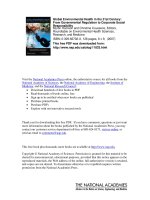Psychology applied to modern life adjustment in the 21st century, 11e chapter 13
Bạn đang xem bản rút gọn của tài liệu. Xem và tải ngay bản đầy đủ của tài liệu tại đây (1.15 MB, 52 trang )
Chapter 13
Careers and Work
Choosing a Career, continued
•
Examining personal characteristics and
family influences
– Personal characteristics
• Choosing a career is best managed by
those whohave secure attachments and a
self-efficacy about work.
• Intelligence predicts likelihood of entering
particular professions but is not an
absolute predictor of career success.
Choosing a Career, continued
Personal characteristics, continued
• Specific aptitudes (e.g., artistic talent)
are more important than general
intelligence.
• Social skills contribute to success in
many careers.
• Careers ideally match one’s interests in
the world and contribute to motivation.
• It is best to find a career that is
compatible with one’s personality.
Choosing a Career, continued
•
Family influences
– Career choices are influenced by family
background because parents and children
often attain similar levels of education.
Thus,
• Middle income background is
associated with high-paying
professions.
• Low income background is associated
with “blue collar” occupations.
Choosing a Career, continued
Family influences, continued
– Parenting style is also associated with
socioeconomic status.
• Middle income families encourage their
children to be curious and independent,
traits well suited for professional roles.
• Low income families teach children to
conform and obey, traits needed to
survive in subordinate positions.
Choosing a Career, continued
•
Researching job characteristics
– Sources of career information include
• The Occupational Outlook Handbook –
a government document that serves as
a comprehensive guide to occupations.
• It is also helpful to talk to individuals
who work in particular fields of interest.
Choosing a Career, continued
Researching job characteristics, continued
• Essential information about occupations
– You should be aware of these key issues
when considering an occupation:
• The nature of the work – what are the
day-to-day responsibilities?
• Working conditions – is it high or low
pressure? pleasant or unpleasant?
Choosing a Career, continued
Essential information, continued
• Job entry requirements – what
education and training are needed?
• Potential earnings.
• Potential status.
• Opportunities for advancement.
• Intrinsic job satisfaction.
• Future outlook – will there continue to
be demand for this occupation?
Choosing a Career, continued
•
Using psychological tests
– Occupational interest inventories –
“measure your interests as they relate to
various jobs or careers”.
– The primary focus is on job satisfaction,
rather than success.
– Scores indicate how similar your interests
are to the typical interests of people in
various occupations.
– However, you must ultimately decide what
is right for you.
Choosing a Career, continued
•
Important considerations
1. You have the potential for success in a
variety of occupations.
2. Don’t choose a career solely on the basis of
salary.
3. There are limits on your career options.
4. Career choice is a developmental process
that extends throughout life.
5. Some career decisions are not easily
undone.
Models of Career Choice, continued
•
Holland’s Person-Environment Fit Model
– Career choice is related to six stable
personality types, or personal
orientations.
– In addition, jobs can be classified into six
work environments (see Figure 13.2).
– People are most satisfied, successful, and
stable when they choose work
environments that fit their personal
orientations.
Figure 13.2. Overview of Holland’s theory of occupational choice. According to John Holland (1985),
people can be divided into six personality types (personal orientations) that prefer different work
environments, as outlined here.
Adapted from Holland, J. L. (1985). Making occupational choices: A theory of occupational
personalities and work environments (2nd ed.). Englewood Cliffs, JF: Prentice-Hall. Adapted by
permission of Prentice-Hall, Inc.
Models of Career Choice, continued
•
Super’s Developmental Model
– Super focuses on the development of
one’s occupational status over time. It
includes five major stages:
1. Growth stage – in childhood, fantasize
about ideal job.
2. Exploration stage – realistically
consider different careers in one’s
youth.
3. Establishment stage – commit to a
career and learn to function effectively.
Models of Career Choice, continued
Super’s model, continued
4. Maintenance stage – at midlife, focus
is on retaining achieved status and
protecting security and power.
5. Decline stage – work activity
decreases as retirement approaches.
– Retirement brings the occupational
cycle to an end.
•. See Figure 13.3 for more detail and the
substages.
Figure 13.3. Overview of Super’s theory of occupational development. According to Donald Super,
people go through five major stages (and a variety of substages) of occupational development over the
lifespan.
Adapted from Zaccaria, J. (1970). Theories of occupational choice and vocational development.
Boston: Houghton Mifflin. Copyright © 1970 by Time Share Corporation, New Hampshire.
Models of Career Choice, continued
•
Women’s career development
– 59% of adult women are in the labor force.
– However, there are still gender gaps in the
world of work.
• Women still subordinate their career
goals to those of their husbands.
• Women’s careers are more likely to be
interrupted by childrearing and family
crises.
The Changing World of Work, continued
•
Workplace trends
1. Technology is changing the nature of work.
• Workers must train and adapt to keep up.
2. New work attitudes are required.
• Workers must take a more active role to
prove that they are valuable in order to
attain job security.
3. Lifelong learning is a necessity.
• Skills become obsolete every 10-15
years.
The Changing World of Work, continued
Workplace trends, continued
4. Independent workers are increasing.
• Downsizing and outsourcing are
creating more “free agents”.
6. Boundaries between work and home are
blurring, due to technology.
7. The highest job growth will occur in the
professional and service occupations (see
Figure 13.4).
8. Job sharing is becoming more common.
Figure 13.4. Fastest growth, high salary occupations. According to the Bureau of Labor (2010),
between 2008 and 2018 these 20 occupations will have the largest number of job openings and provide
highest pay. Median annual salaries range from $85,430 (computer software engineers, applications) to
$20,460 (home health aides). (Adapted from Occupational Outlook Handbook, 2010-2011).
Source: Table 1, />
The Changing World of Work, continued
•
Education and earnings
– Earnings are tied to level of education
(see Figure 13.5).
– However, many college graduates are
underemployed – “settling for a job that
does not fully utilize one’s skills, abilities,
and training”.
• This is most likely if college-level
reading, writing, and quantitative skills
are poor.
Figure 13.5. Education and income. This graph
shows the average incomes of year-round, full-time
workers aged 18 and over, by gender and
educational attainment. As you can see, the more
education people have, the higher their income
tends to be. However, at all levels, women earn less
than men with comparable education. (Data from
U.S. Census Bureau, 2006)
The Changing World of Work, continued
•
The changing workforce
– Today’s labor force – “those who are
employed as well as those who are
currently unemployed but are looking for
work” – is becoming more diverse (see
Figure 13.6).
• More women are joining the labor force.
• The workforce is becoming more
ethnically diverse.
Figure 13.6. Increasing diversity in the workforce. Women and minority group members are entering the
workforce in greater numbers than before. This graph projects changes in the share of the labor force by
gender and by ethnicity between 1990 and 2010. (Data from U.S. Bureau of Labor Statistics, 2002)
The Changing World of Work, continued
The changing workforce, continued
• Today’s workplace for women and minorities
– Although illegal, discrimination against women
and minorities still occurs.
– Women and minorities often face a glass
ceiling – “an invisible barrier that prevents most
women and ethnic minorities from advancing to
the highest levels of occupations” (see Figure
13.7).
Figure 13.7. The glass ceiling for women and minorities. A longitudinal study looked at the chances of
promotion to a managerial position in a sample of more than 26,000 adults over 30 years of career
experience. This graph shows that promotion chances increased along with career experience for white
men. By contrast, the promotion chances of white women and black men were much lower. As you can
see, black women lagged far behind all groups. These trends are consistent with the existence of a glass
ceiling for women and minorities.
From Maume, D. J. (2004). Is the Glass Ceiling a Unique Form of Inequality? Work and Occupations,
31(2), 250-274. Figure 2, p. 266. [Journal published by Sage]









